
If you ever venture to Montreal, be sure to visit one of the most interesting botanical gardens in the world that includes unique themed gardens. One of the more unusual gardens was the poisonous plants area surrounded by a high wooden fence with a very noticeable danger sign.
You have probably heard one of these sayings:
Raggy rope, don’t be a dope!
Leaves of three; Let it be!
Hairy vine, no friend of mine.
Berries white, run in fright.
If you haven’t figured out what these sayings are referring to, you must not have any experience with the great outdoors. Poison Ivy, Toxicodendron radicans, which is the bane of many a gardener and outdoorsman is just starting to leaf out this spring. When I did maintenance on gardens professionally, I encountered poison ivy many times. I knew exactly what it looked like in all stages of development but sometimes the vine was so entwined into the weeds and other vegetation that it was very hard to avoid.
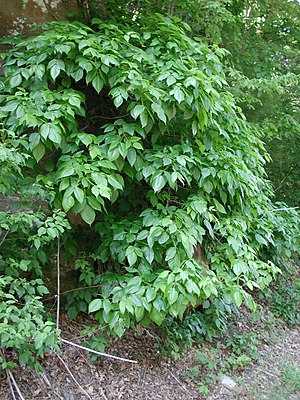
Avoidance At All Costs
The most likely time for me to encounter poison is in the early spring or winter before the vine leafs out and becomes visible. Sometimes while working in the garden you don’t notice the thin innocuous looking woody vine. You can still get poison ivy from the stem of the plant with no leaves showing. My husband got a severe case when we went to a “cut your own” Christmas tree farm to bring home the perfect Christmas tree. He grabbed the dried up vines and debris at the trunk of the Fraser Fir that we had carefully selected, to clear them out prior to sawing the trunk. You guessed it! It was poison ivy and he got the worst case I have ever seen just in time for Christmas!
All parts are highly poisonous to people, the roots, stems, berries, and leaves. Urushiol is the clear liquid compound that is the culprit that causes a painful itching and rash.

You can barely brush past the vine and pick up the oil very easily. If I know that I have encountered the leaves by accident, I quickly wash off the area thoroughly with soap and water. Or for a down and dirty method where soap and water are not an option, rub the affected part in dirt. But you have to do this immediately – don’t delay.
I always wear long sleeves and pants if I think that I will be working close to the vine. If I pull it out, then I put plastic bags over my hands fastened with rubber bands. The vines and roots I stuff into a trash bag and get rid of it, and not in my compost pile!
Product
There are lots of products on the market supposed to help with the itch and to stop you from getting the oil on your skin.
I like TECNU which is a liquid that you apply and forms a film over your skin to protect you from contacting the oil. I use it and think it works great but you have to reapply if you sweat or it rubs off.
I have been exposed to the oil after my dog has run through some poison ivy, and then petted her not knowing about her brief encounter. The oil is very long-lasting and can be transmitted on clothing, gloves, tools and fur!. I have even set my gloves down on my car seat and the oil was transferred from the gloves to the material of the seat and then sat in it for an interesting rash! The oil can remain there and keep on being transferred for a long time.

I am highly allergic to it and have had it so many times that I can speak from experience about the pain and discomfort of contracting poison ivy. The rash is long-lasting, extremely itchy, very painful, and downright ugly! The giveaway that points to poison ivy is the fluid filled blisters. A bad case can last up to 4 weeks and leave scars for much longer.
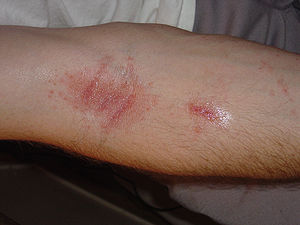
Now, if I get a bad case, I go straight to the doctor who will put me on steroids which quickly nips the rash in the bud and saves me from all kinds of discomfort.
Poison Ivy Factoids
- Poison Ivy is not a true Ivy and can come in three forms: a trailing vine on the ground 4 – 10″ high, a shrub up to 4′ high, and a woody climbing vine that grows on trees for support.
- The vine can grow up to a hundred feet and the base of the vine can look thick and woody, with scrubby hairs and no leaves. People who touch the vine not seeing the leaves will not realize that it is poison ivy until they develop a rash.
- The oil Urushiol is extremely potent – A billionth of a gram can start an allergic reaction! It is so potent that only 1/4 of a cup of urushiol would be needed to cause a rash for every person on earth!
- Urushiol will remain active for one to 5 years. There have even been specimens from dead plants that cause a reaction centuries later.
- Allergies to poison ivy or poison oak, the western version, is the most common allergy on the planet. At least 90% of people are allergic.
- Sensitivity to urushiol can develop at any time and the more you are exposed to it, the greater the reaction.
- The name Poison Ivy was coined by Captain John Smith in 1609.
- Poison Ivy is not contagious but by scratching the rash, you can make it much worse, even infected.
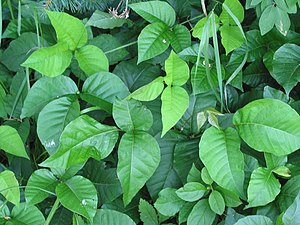
Identifying
Even though the saying is to avoid leaves of three, there are other plants that have three leaves, most commonly juvenile leaves of Virginia Creeper. The leaves of Virginia Creeper have a few more serrations along the leaf edge but the differences are very difficult to pick up by even the most experienced gardener. Another similar looking plant is Box Elder. This can fool even the most experienced plants person and you have to closely examine it to make sure.

I am always amazed at the number of people who do not recognize poison ivy. I even have had neighbors ask me to find it in their yards when their kids develop the telltale rash and blisters. I usually can find it right away and it is in plain sight!
Climate Change is Affecting Poison Ivy
According to the article http://www.green-talk.com/2010/07/22/poison-ivy-spreading-due-to-climate-change-says-npr/, because of climate change, poison ivy is growing faster and the oil has become more virulent because of the increase of Carbon Dioxide in the atmosphere. Since poison ivy thrives in disrupted forest areas, it is also spreading due to urban sprawl.
When I walk my dog every day in the summer, I see large billowing banks of poison ivy on either side of the road that choke out any other species. But it is a native species that has evolved to take advantage of its environment and in the process is taking over large areas.
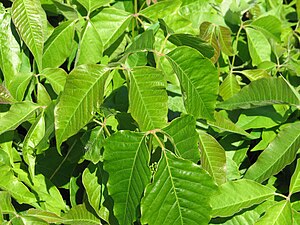
The Garden of Poison
So, back to that poison sign from the Montreal Botanical Garden. I visited there a couple of years ago with some bored young adults who know that I go “ga ga” over any notable gardens in my travels. I convinced them to go with me to this world-renowned botanical garden and promised them there would be interesting things to see. Little did I know that the botanical garden had an area dedicated to poisonous plants. This was the hit of the day! I couldn’t believe that they had planted and were growing poison ivy along with some other noxious plants. Poison hemlock, stinging nettle, monkshood, and wild parsnip were growing right next to poison ivy. It was a veritable smorgsabord of poison!

Good Things?
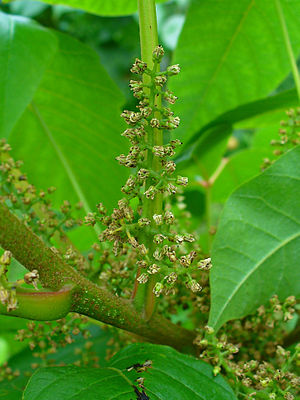
Yes, there are some good attributes to poison ivy. But I really have to try hard for these since I hate it so much!
The berries are useful for wildlife in the fall and winter, especially birds. When food is scarce, the berries are very important to other animals also.

Surprise, surprise!Bees also frequent the flowers for nectar. I did not know this and wonder if the urushiol is transferred to the finished product? I do know that some honey can be harmful, such as honey collected from Rhododendron flowers which can be toxic.
Lastly, the vines turn a spectacular flaming scarlet in the fall. I enjoy them from a distance!!!
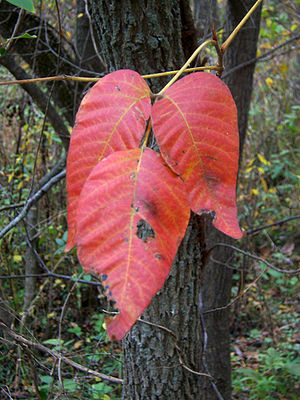
Related articles
- Why does poison ivy cause a rash? (boyslife.org)
- Poison Ivy Spreading Due to Climate Change, Says NPR (green-talk.com)
- Poison Ivy (monkdiwonk.wordpress.com)
- Rash Decisions (patsyporco.wordpress.com)
- The Reluctant Forb Killer (floraexplored.wordpress.com)
If you like this post, share with Stumbleupon!


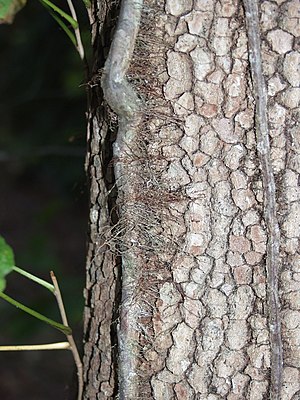

That was great, Claire! I intend to do a future post in which I have photographed all the other plants that can be mistaken for poison ivy so people new to living in the country will be able to discern the true villain. I live in the south-central part of Texas out in the country and we have Virginia Creeper (with 5 leaves now, but it still confuses some people) and tons of wild blackberries with 3 leaf groupings, grapevines and other vines, which can cause confusion. Like you, I have had so many “hits” from this vine that I am over-sensitized now. One of my worst cases was making Christmas wreaths from hand-cut greenery. The dead vine must have been tangled in some of the greenery. We have a lot in common, except I have never been on the professional side of gardening. I am looking forward to keeping up with your posts.
Mary Evelynn
Thanks! I had visitors from Japan who had never heard of poison ivy and that is when I learned that it is native to North America and doesn’t exist anywhere else. Lucky devils!
Spot on with this write-up, I seriously feel
this site needs a great deal more attention.
I’ll probably be returning to see more, thanks for the information!
Great, Glad you like it!
I am sorry to tell you , but poison ivy can be found in Europe and in China
Thanks, I just changed my post!
Poison ivy is mixed with blackberries.
If I kill the ivy with vinegar, salt and soap, is it safe to eat the blackberries if washed thoroughly?